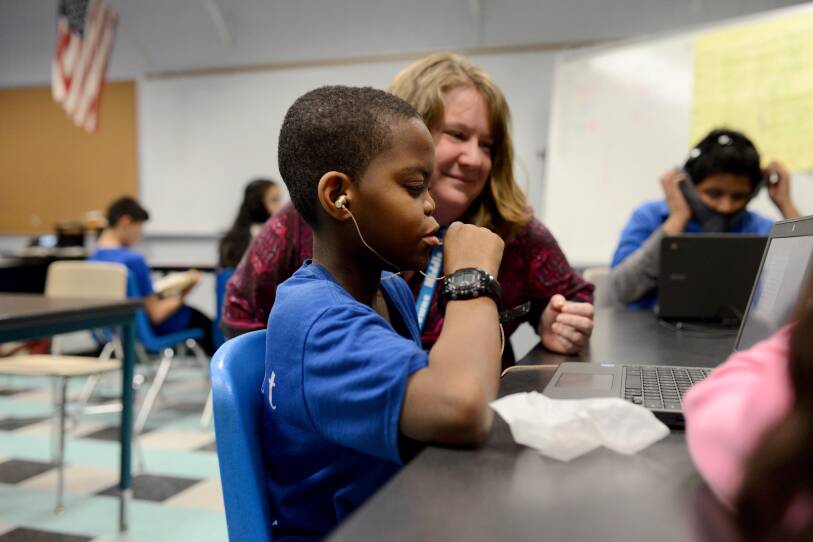School is over for the day, but a group of seventh graders in Chelsea is staying after class for extra help in reading.
“I want you to take a minute to write down a prediction at the bottom of page 38 about what will happen in this story,” Browne Middle School teacher Kathryn Anderson says to the five students sitting around the table.
The story they’re reading is about a forest fire. Anderson reads the title and caption and asks the students to guess what the story is about.
“They’re mostly going to talk about the dangers of fire and what causes that,” says one boy.
These students work on reading during the regular school day, but that’s not enough, says Browne Middle School Principal Julie Shea.

More Time
“We need time,” says Shea. “We know that our students, for many of them their first language is not English. So, we want to continue to support them to develop those literacy skills in English.”
Shea believes this program helps her students, but her district doesn’t know if it can afford it. They already cut after-school programs for elementary school children. Another budget shortfall means the activities for middle and high schools students may have to go, too.
“Everything that we know is in the best interest of students we’re starting to see we have to whittle away,” says Chelsea Superintendent Mary Bourque. “And that, for me, is the most heartbreaking piece.”
Chelsea’s problems stem from way the state pays for education. When lawmakers devised a formula 25 years ago to help districts provide an adequate education to all students, they underestimated just how much health insurance and special education costs would rise. Now these line items are gobbling up school budgets across the state.
Misunderstood
But there’s another problem that’s particular to places like Chelsea, a district where about 30 percent of students are English language learners and more than half are low-income.
“We did not adequately understand how hard it would be to close achievement gaps,” says Massachusetts State Senator Sonia Chang-Diaz.
Chang-Diaz, who also co-chairs the statehouse’s joint committee on education, points to research showing that — if you want to do it right — it costs a lot more to educate kids who don’t speak English and come from poor families.
Chang-Diaz blames the current funding model for some of the gaps in learning between these students and everyone else.
“Although we have very high achievement levels in Massachusetts, that average masks very deep achievement gaps,” says Chang-Diaz. “We need to double down on our investments to close achievement gaps.”
Chang-Diaz has sponsored abillat the statehouse that would increase the money districts receive for low-income children and English language learners. It would also adjust the allotment for staff healthcare costs and special education. It would cost about $1.4 billion over seven years.
Big Expenditure
It’s not clear where that money would come from.
“It’s a big expenditure,” says Eileen McAnneny, president of the Massachusetts Taxpayers Foundation. “It’s being added to a budget that already has a structural deficit. So, figuring out how we pay for that is critically important.”
As Chelsea school officials try to balance its budget, they’ll have to make tough choices about which programs will have the least impact on children if they disappear.
Superintendent Bourque says she hopes the state can find a way to get more money to districts like hers. Places like Lawrence, Framingham and Brockton all stand to benefit, but she says people should understand this issue goes beyond so-called “Gateway Cities.”
“It is the future,” says Bourque. “We are going to become more and more diverse. More and more English-language learners. It may not feel like it’s our problem in some places today. But tomorrow and the next day, it’s everybody’s problem.”
People seem to recognize this in the state legislature. All sitting senators have signed onto the bill, but it’s unclear when it might come up for a senate vote.
Our coverage of K through 12 education is made possible with support from the Nellie Mae Education Foundation.





